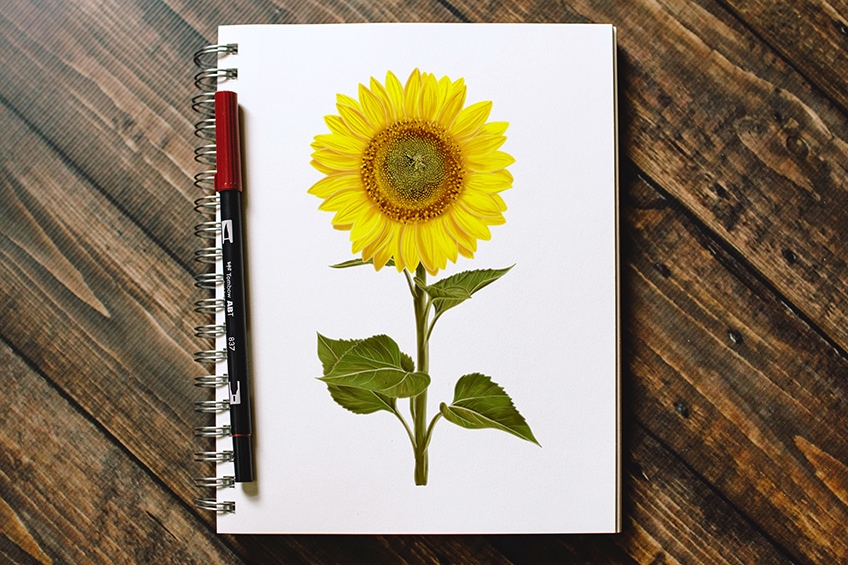Easy Flowers to Paint – Learn How to Create Your Own Bouquet
Flowers are a delightful subject for artists of all skill levels, offering vibrant colors, diverse shapes, and endless creative possibilities. Whether you’re a budding artist or an experienced painter, easy flowers to draw and paint can be a wonderful way to explore your artistic talents. In this article, we’ll dive into simple yet stunning floral designs that will brighten your canvas and bring a touch of nature into your artwork. Grab your pencils, brushes, and a splash of color—let’s create a blooming masterpiece together!
Learning How to Draw Flowers
Learning how to draw flowers is an exciting and rewarding process that enhances your artistic skills and appreciation for nature’s beauty. Start by observing real flowers, noting their shapes, patterns, and textures. Break down the flower into simple geometric shapes, like circles and ovals, to capture its basic form before adding details like petals, stems, and leaves. Practice regularly, experiment with different flowers, and don’t be afraid to make mistakes—each sketch brings you closer to mastering the art of floral drawing!

As you progress in drawing flowers, try exploring various styles and techniques to add depth and personality to your artwork. Experiment with line weights to create dynamic outlines, and use shading to give your flowers a three-dimensional appearance. Incorporate different media, such as colored pencils, watercolors, or markers, to bring vibrant hues and textures to your drawings. Additionally, consider studying the works of botanical artists and illustrators for inspiration and guidance. With patience and practice, your floral drawings will bloom with life and creativity.
Our Top Flower Drawing Tutorials to Check Out
Whether you’re a novice looking to hone your skills or a seasoned artist seeking new inspiration, these tutorials are designed to guide you through the art of capturing nature’s beauty on paper. From basic techniques to advanced tips, each tutorial offers step-by-step instructions and helpful insights to help you create stunning floral artwork. Get ready to immerse yourself in the world of flower drawing and unleash your creativity with these invaluable resources.
These tutorials will help you explore and appreciate the unique characteristics of each flower type, guiding you through techniques to capture their beauty and symbolism on paper. Happy drawing!
Carnation
Carnations are known for their ruffled petals and range of colors from soft pinks to vibrant reds. Begin by sketching a central circular shape for the flower’s base and add layered, jagged-edged petals around it. Carnations symbolize love and fascination, making them a favorite in bouquets and floral arrangements. Explore our drawing tutorial here for step-by-step guidance on capturing their intricate beauty.

Forget-Me-Not
Forget-Me-Nots feature tiny, delicate blossoms in shades of blue with distinctive yellow centers. Start with small, rounded shapes clustered together to form the flower head and add delicate lines for the petals. These charming flowers symbolize remembrance and enduring love, often found in gardens and wildflower meadows.
Discover our drawing tutorial here to learn how to depict their dainty allure.

Tulip
Tulips are elegant flowers with smooth, cup-shaped petals that come in a variety of colors, including red, yellow, and purple. Begin by sketching a basic oval shape for the flower’s head and add curved lines to outline the petals. Tulips symbolize perfect love and are celebrated for their graceful appearance in gardens and floral displays.
Check out our drawing tutorial here for techniques on capturing their graceful curves.

Hydrangea
Hydrangeas are known for their clusters of small, fluffy flowers in shades of blue, pink, and white. Start by drawing a rounded shape for the flower cluster and add tiny, densely packed petals around it. These flowers symbolize gratitude and heartfelt emotions, often used in weddings and decorative arrangements.
Learn more about drawing hydrangeas in our tutorial here for tips on rendering their intricate clusters.

Lily
Lilies are majestic flowers with large, trumpet-shaped blooms and prominent stamens. Begin by sketching a long, oval shape for the flower’s head and add gentle curves for the petals. Lilies symbolize purity and renewal, making them popular in religious ceremonies and gardens.
Dive into our drawing tutorial here to discover how to capture the elegance of lilies with finesse.

Poppy
Poppies are characterized by their vibrant petals in shades of red, orange, and pink, often with a dark center. Begin by sketching a circular shape for the flower head and add soft, irregular petals radiating outward. Poppies symbolize peace and remembrance, prominently featured in fields and gardens alike.
Explore our drawing tutorial here to learn techniques for capturing the delicate balance of color and form in poppies.

Orchid
Orchids are exotic flowers known for their intricate shapes and striking colors, ranging from delicate whites to vibrant purples and yellows. Start by sketching a basic oval shape for the flower’s head and add detailed lines to depict the orchid’s unique petals and patterns. Orchids symbolize beauty and luxury, often cultivated indoors and prized for their rarity.
Discover our drawing tutorial here for insights into portraying the elegance and allure of orchids.

Magnolia
Magnolias boast large, fragrant blossoms with creamy white petals and a subtle pink or purple hue at their base. Begin by drawing a large, rounded shape for the flower and add broad, overlapping petals around it. Magnolias symbolize beauty, perseverance, and dignity, cherished in gardens and floral arrangements.
Check out our drawing tutorial here to master the graceful curves and textures of magnolia flowers.

Hibiscus
Hibiscus flowers are known for their large, trumpet-shaped blooms in shades of red, pink, yellow, and white, often with a contrasting center. Start by sketching a circular shape for the flower head and add broad, curved petals radiating outward. Hibiscus symbolizes beauty, youth, and delicate charm, popular in tropical gardens and as a symbol of hospitality.
Learn more about drawing hibiscus flowers in our tutorial here for techniques on capturing their vibrant colors and intricate details.

Calla Lily
Calla lilies feature elegant, trumpet-shaped blooms in shades of white, cream, yellow, and pink, with long, smooth-edged leaves. Begin by sketching a long, tapered shape for the flower and add gentle curves to define the petals and spadix. Calla lilies symbolize purity, faithfulness, and rebirth, often used in weddings and formal arrangements.
Dive into our drawing tutorial here to discover how to depict the graceful simplicity of calla lilies with precision and grace.

Lotus
Lotuses are aquatic flowers with large, round blooms and distinctive, layered petals in shades of pink, white, and blue. Start by sketching a circular shape for the flower head and add concentric circles of petals, gradually increasing in size. Lotuses symbolize purity, enlightenment, and spiritual growth, revered in many cultures and often depicted in art and architecture.
Explore our drawing tutorial here for techniques on capturing the serene beauty and symbolism of lotus flowers.

Peony
Peonies are lush flowers with layers of soft, ruffled petals in shades of pink, red, white, and yellow. Begin by drawing a large, rounded shape for the flower head and add overlapping petals to create a full, voluminous appearance. Peonies symbolize prosperity, romance, and compassion, beloved for their fragrance and stunning appearance in gardens and bouquets.
Discover our drawing tutorial here for insights into portraying the luxurious texture and vibrant colors of peonies.

Daffodil
Daffodils are cheerful flowers with trumpet-shaped blooms in shades of yellow, white, and orange, often with a contrasting center. Start by sketching a long, trumpet-like shape for the flower head and add frilled edges to define the petals. Daffodils symbolize new beginnings, hope, and rebirth, heralding the arrival of spring in gardens and landscapes.
Check out our drawing tutorial here to learn techniques for capturing the bright, sunny essence of daffodils on paper.

Dandelion
Dandelions are delicate flowers with fluffy, spherical seed heads and slender stems, often depicted in their iconic yellow bloom. Begin by sketching a circular shape for the flower head and add fine lines to depict the seeds and stem. Dandelions symbolize resilience, freedom, and the passage of time, found in fields and meadows worldwide.
Explore our drawing tutorial here for tips on capturing the ethereal beauty and symbolism of dandelions.

Daisy
Daisies are simple yet charming flowers with white petals and a bright yellow center, known for their cheerful appearance. Start by sketching a small circle for the flower head and add short, pointed petals radiating outward. Daisies symbolize innocence, purity, and new beginnings, often found in gardens, meadows, and floral arrangements.
Explore our drawing tutorial here for techniques on capturing the simplicity and joy of daisies in your artwork.

Sunflower
Sunflowers are bold and iconic flowers with large, golden-yellow petals and a dark center. Begin by drawing a large, circular shape for the flower head and add overlapping petals with distinct textures. Sunflowers symbolize adoration, loyalty, and longevity, celebrated for their vibrant colors and association with sunshine.
Check out our drawing tutorial here to learn how to depict the striking beauty and vitality of sunflowers on paper.

Cherry Blossom
Cherry blossoms are delicate flowers with five-petaled blooms in shades of pink and white, heralding the arrival of spring in many cultures. Start by sketching a small, rounded shape for the flower head and add fine, curved lines for the petals. Cherry blossoms symbolize beauty, renewal, and the fleeting nature of life, prominently featured in Japanese art and festivals.
Discover our drawing tutorial here for insights into capturing the ethereal charm and cultural significance of cherry blossoms.

Rose
Roses are classic flowers known for their layered petals and captivating fragrance, available in a wide range of colors from red and pink to yellow and white. Begin by sketching a rounded shape for the flower head and add overlapping petals with gentle curves and folds. Roses symbolize love, passion, and romance, cherished in gardens, bouquets, and as a timeless symbol in art and literature.
Dive into our drawing tutorial here to master the art of drawing roses, from buds to fully bloomed flowers, with elegance and detail.

Drawing and painting flowers can be a delightful journey that blossoms into beautiful creations. With each petal and leaf, you’ve unlocked a bit more of your artistic potential and added a splash of color to your world. Remember, the joy of art lies in the process, so keep experimenting with different flowers and techniques. Whether it’s a simple daisy or an elegant rose, let your creativity flourish and your passion for art bloom. So, gather your supplies, find your inspiration in nature, and continue to create floral wonders that will forever brighten your artistic journey!
Frequently Asked Questions
How Can I Improve My Flower Drawing Skills?
Practice regularly and observe real flowers for their shapes, textures, and details. Experiment with different drawing techniques, such as shading, cross-hatching, and blending. Study tutorials and guides that focus on specific flower types to learn new approaches and styles.
How Do I Choose the Right Flower to Draw?
Consider your skill level and familiarity with different flower types. Choose a flower that inspires you or has personal significance. Start with simpler flowers like daisies or tulips before tackling more complex ones such as orchids or peonies.
How Can I Make My Flower Drawings More Realistic?
Focus on capturing the proportions and symmetry of the flower. Pay attention to light and shadow to create depth and dimension. Use observational drawing techniques to depict the intricate details, such as veins on petals or textures on leaves. Practice drawing from life to understand how flowers look in different lighting conditions and angles.
Isabella studied at the University of Cape Town in South Africa and graduated with a Bachelor of Arts majoring in English Literature & Language and Psychology. Throughout her undergraduate years, she took Art History as an additional subject and absolutely loved it. Building on from her art history knowledge that began in high school, art has always been a particular area of fascination for her. From learning about artworks previously unknown to her, or sharpening her existing understanding of specific works, the ability to continue learning within this interesting sphere excites her greatly.
Her focal points of interest in art history encompass profiling specific artists and art movements, as it is these areas where she is able to really dig deep into the rich narrative of the art world. Additionally, she particularly enjoys exploring the different artistic styles of the 20th century, as well as the important impact that female artists have had on the development of art history.
Learn more about Isabella Meyer and the Art in Context Team.









